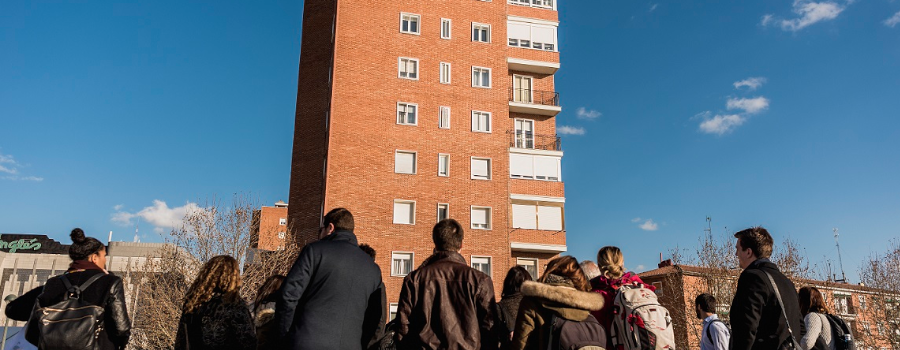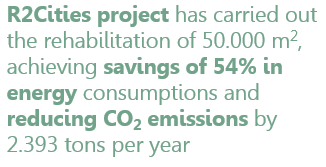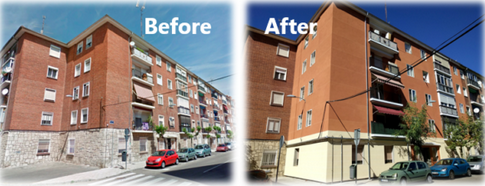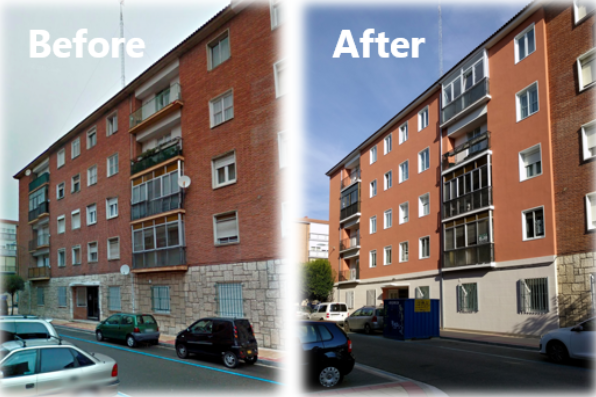
The beginning of Valladolid as Smart City

R2CITIES, the Smart City project with which our city began the road towards efficiency and sustainability, has come to an end. Five years of project, and some more until it materialized, have been necessary to design, implement and evaluate the energy rehabilitation of three districts in cities as different socio-economically and urbanistically as Valladolid (in Spain), Genoa (in Italy) and Kartal (in Turkey). The project, funded by the European Commission under the FP7 program and coordinated by the CARTIF Technology Centre, has developed a methodology that guarantees success in its implementation for large-scale interventions in the energy rehabilitation of districts.
The main activities in Valladolid have been carried out in the neighborhood of Cuatro de Marzo. For a few months, the 13 residential buildings which have been rehabilitated energically are perfectly recognizable, although without losing the identity that marks the aesthetics of the neighborhood. Each of these properties has undergone a series of common modifications:
- Installation of a thermal insulation in facade and roofs.
- Replacing and bending windows.
- Installation of solar panels to cover 60% of the demand for domestic hot water (DHW).
- Renewal of boilers.
- Installation of high efficiency luminaires in the common areas of buildings.

To complement the works and verify their effectiveness, the information on energy consumption and the comfort parameters of the interior of the dwellings (temperature, humidity and CO2 concentration) has been analyzed in order to evaluate the efficiency of the implemented solutions.
As I commented at the beginning of this text, R2CITIES was the first major city project that CARTIF proposed to the City Council and, therefore, to the city of Valladolid. In 2012, the concept of “Smart City” was still unknown to most citizens. In essence, what the EU tried to promote was the awareness of the consumers of resources, since our consumption was excessive and, what is worse, unsustainable. For this reason, these projects proposed solutions at the district (or neighborhood) scale to drastically improve the energy efficiency of those homes built decades ago, when the current environmental saving and sustainability standards were not determining factors for the construction sector.
Applying state-of-the-art technological solutions, these projects wanted to demonstrate, in a practical and measurable way, that the cost of electricity and gas could be reduced and, in addition, the comfort of the tenants of the dwellings could be considerably improved.
In the specific case of the Cuatro de Marzo, a residential neighborhood located in the center of Valladolid and whose homes were built in the 50s, numerous problems caused by moisture condensation in facades or in rooms that do not achieve rise of 17ºC with heating at full capacity have been solved. All this thanks to the isolation of the buildings. In addition to achieving significant savings in the heating bill, which is crucial in a region with a climate of extreme temperatures.
Additionally, and available to electric vehicle users throughout the city, it has been installed a recharging point powered by solar energy that captures a 3.7 kWp photovoltaic marquee located inside the neighborhood.

Another feature common to smart city projects is that practical demonstrators are located in several cities. In the case of R2CITIES, the elected ones were the districts of Lavatrici, in Genoa, and Yakacik, in Kartal. In total, more than 49,500 m2 have been renovated in the three cities involved, achieving an overall reduction of 5,342,672 kWh / year in primary energy consumed (which represents an energy saving of 54%), while at the same time they stop emitting 2,393 t of CO2 per year.
Through the journey carried out in R2CITIES, we had the opportunity to expand our knowledge and experience in the energy renovation of urban residential spaces. With the future goal of having almost zero energy consumption cities, our project has implemented a set of technological solutions in the three demonstrators to reduce their energy demand and increase the use of renewable energy in them. This has allowed us to face both technical challenges and overcome numerous socio-economic barriers, allowing us to gain experience in large-scale district renewal strategies that we would like to share with all the professionals involved in the sector.
Both results obtained and experience gained, we share them with you through the material available on the website of our project, as well as we did in the conference By & For Citizens that was held in Valladolid on September 20 and 21. A conference where, in addition to R2CITIES ‘experience, the other city projects that we lead were presented: CITyFiED, REMOURBAN, mySMARTLife and UrbanGreenUp.